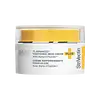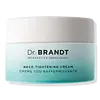What's inside
What's inside
 Key Ingredients
Key Ingredients

 Benefits
Benefits

 Concerns
Concerns

 Ingredients Side-by-side
Ingredients Side-by-side

Water
Skin ConditioningButyrospermum Parkii Butter
Skin ConditioningGlycerin
HumectantBis-Stearyl Dimethicone
EmollientMyristyl Nicotinate
Skin ConditioningTrimethylolpropane Tricaprylate/Tricaprate
EmollientCetearyl Alcohol
EmollientIsononyl Isononanoate
EmollientBehenyl Alcohol
EmollientPropanediol
SolventCaprylic/Capric Triglyceride
MaskingGlyceryl Stearate
EmollientOryza Sativa Bran Extract
Skin ConditioningHelianthus Annuus Extract
EmollientAdenosine
Skin ConditioningArctostaphylos Uva Ursi Leaf Extract
Skin ConditioningOryza Sativa Extract
AbsorbentRosmarinus Officinalis Leaf Extract
AntimicrobialNannochloropsis Oculata Extract
HumectantAcmella Oleracea Extract
Skin ProtectingOryza Sativa Germ Extract
EmollientAcetyl Dipeptide-1 Cetyl Ester
Skin ConditioningGlycine Soja Oil
EmollientPentapeptide-76 Amide
Butylene Glycol
HumectantAcrylates/C10-30 Alkyl Acrylate Crosspolymer
Emulsion StabilisingPolyglyceryl-3 Diisostearate
EmulsifyingSodium Acrylate/Sodium Acryloyldimethyl Taurate Copolymer
Emulsion StabilisingCeteareth-20
CleansingSorghum Bicolor Stalk Juice
Skin ConditioningSclareolide
MaskingPentylene Glycol
Skin ConditioningTrisodium Ethylenediamine Disuccinate
Polyisobutene
Sodium Polystyrene Sulfonate
Emulsion StabilisingHydrated Silica
AbrasiveEthylhexyl Isononanoate
Emollient1,2-Hexanediol
Skin ConditioningPullulan
Caprylhydroxamic Acid
Beta-Glucan
Skin ConditioningCaprylyl Glycol
EmollientSorbitan Oleate
EmulsifyingHydroxyethylcellulose
Emulsion StabilisingCaprylyl/Capryl Glucoside
CleansingSorbitan Laurate
EmulsifyingTocopherol
AntioxidantPEG-40 Stearate
EmulsifyingParfum
MaskingAminomethyl Propanol
BufferingPotassium Sorbate
PreservativeSodium Benzoate
MaskingCitric Acid
BufferingLimonene
PerfumingWater, Butyrospermum Parkii Butter, Glycerin, Bis-Stearyl Dimethicone, Myristyl Nicotinate, Trimethylolpropane Tricaprylate/Tricaprate, Cetearyl Alcohol, Isononyl Isononanoate, Behenyl Alcohol, Propanediol, Caprylic/Capric Triglyceride, Glyceryl Stearate, Oryza Sativa Bran Extract, Helianthus Annuus Extract, Adenosine, Arctostaphylos Uva Ursi Leaf Extract, Oryza Sativa Extract, Rosmarinus Officinalis Leaf Extract, Nannochloropsis Oculata Extract, Acmella Oleracea Extract, Oryza Sativa Germ Extract, Acetyl Dipeptide-1 Cetyl Ester, Glycine Soja Oil, Pentapeptide-76 Amide, Butylene Glycol, Acrylates/C10-30 Alkyl Acrylate Crosspolymer, Polyglyceryl-3 Diisostearate, Sodium Acrylate/Sodium Acryloyldimethyl Taurate Copolymer, Ceteareth-20, Sorghum Bicolor Stalk Juice, Sclareolide, Pentylene Glycol, Trisodium Ethylenediamine Disuccinate, Polyisobutene, Sodium Polystyrene Sulfonate, Hydrated Silica, Ethylhexyl Isononanoate, 1,2-Hexanediol, Pullulan, Caprylhydroxamic Acid, Beta-Glucan, Caprylyl Glycol, Sorbitan Oleate, Hydroxyethylcellulose, Caprylyl/Capryl Glucoside, Sorbitan Laurate, Tocopherol, PEG-40 Stearate, Parfum, Aminomethyl Propanol, Potassium Sorbate, Sodium Benzoate, Citric Acid, Limonene
Water
Skin ConditioningGlycerin
HumectantCoco-Caprylate/Caprate
EmollientPropanediol
SolventEthyl Oleate
EmollientCaprylic/Capric Triglyceride
MaskingCetearyl Alcohol
EmollientSilica
AbrasiveHydrogenated Vegetable Glycerides
EmollientHydroxypropyl Starch Phosphate
Sodium Stearoyl Glutamate
CleansingAnthemis Nobilis Flower Oil
MaskingBacillus Ferment
Skin ConditioningCetearyl Glucoside
EmulsifyingGlycolic Acid
BufferingLactic Acid
BufferingLavandula Angustifolia Oil
MaskingLevulinic Acid
PerfumingMagnesium Chloride
Punica Granatum Pericarp Extract
Skin ConditioningRicinus Communis Seed Oil
MaskingSecale Cereale Seed Extract
AbrasiveSodium Hydroxide
BufferingSodium Levulinate
Skin ConditioningSodium Phytate
Tetradecyl Aminobutyroylvalylaminobutyric Urea Trifluoroacetate
Skin ConditioningTocopherol
AntioxidantXanthan Gum
EmulsifyingSodium Benzoate
MaskingLinalool
PerfumingWater, Glycerin, Coco-Caprylate/Caprate, Propanediol, Ethyl Oleate, Caprylic/Capric Triglyceride, Cetearyl Alcohol, Silica, Hydrogenated Vegetable Glycerides, Hydroxypropyl Starch Phosphate, Sodium Stearoyl Glutamate, Anthemis Nobilis Flower Oil, Bacillus Ferment, Cetearyl Glucoside, Glycolic Acid, Lactic Acid, Lavandula Angustifolia Oil, Levulinic Acid, Magnesium Chloride, Punica Granatum Pericarp Extract, Ricinus Communis Seed Oil, Secale Cereale Seed Extract, Sodium Hydroxide, Sodium Levulinate, Sodium Phytate, Tetradecyl Aminobutyroylvalylaminobutyric Urea Trifluoroacetate, Tocopherol, Xanthan Gum, Sodium Benzoate, Linalool
Ingredients Explained
These ingredients are found in both products.
Ingredients higher up in an ingredient list are typically present in a larger amount.
This ingredient is an emollient, solvent, and texture enhancer. It is considered a skin-softener by helping the skin prevent moisture loss.
It helps thicken a product's formula and makes it easier to spread by dissolving clumping compounds.
Caprylic Triglyceride is made by combining glycerin with coconut oil, forming a clear liquid.
While there is an assumption Caprylic Triglyceride can clog pores due to it being derived from coconut oil, there is no research supporting this.
Learn more about Caprylic/Capric TriglycerideCetearyl alcohol is a mixture of two fatty alcohols: cetyl alcohol and stearyl alcohol. It is mainly used as an emulsifier. Emulsifiers help prevent the separation of oils and products. Due to its composition, it can also be used to thicken a product or help create foam.
Cetearyl alcohol is an emollient. Emollients help soothe and hydrate the skin by trapping moisture.
Studies show Cetearyl alcohol is non-toxic and non-irritating. The FDA allows products labeled "alcohol-free" to have fatty alcohols.
This ingredient is usually derived from plant oils such as palm, vegetable, or coconut oils. There is debate on whether this ingredient will cause acne.
Due to the fatty acid base, this ingredient may not be Malassezia folliculitis safe.
Learn more about Cetearyl AlcoholGlycerin is already naturally found in your skin. It helps moisturize and protect your skin.
A study from 2016 found glycerin to be more effective as a humectant than AHAs and hyaluronic acid.
As a humectant, it helps the skin stay hydrated by pulling moisture to your skin. The low molecular weight of glycerin allows it to pull moisture into the deeper layers of your skin.
Hydrated skin improves your skin barrier; Your skin barrier helps protect against irritants and bacteria.
Glycerin has also been found to have antimicrobial and antiviral properties. Due to these properties, glycerin is often used in wound and burn treatments.
In cosmetics, glycerin is usually derived from plants such as soybean or palm. However, it can also be sourced from animals, such as tallow or animal fat.
This ingredient is organic, colorless, odorless, and non-toxic.
Glycerin is the name for this ingredient in American English. British English uses Glycerol/Glycerine.
Learn more about GlycerinPropanediol is an all-star ingredient. It softens, hydrates, and smooths the skin.
It’s often used to:
Propanediol is not likely to cause sensitivity and considered safe to use. It is derived from corn or petroleum with a clear color and no scent.
Learn more about PropanediolSodium Benzoate is a preservative. It's used in both cosmetic and food products to inhibit the growth of mold and bacteria. It is typically produced synthetically.
Both the US FDA and EU Health Committee have approved the use of sodium benzoate. In the US, levels of 0.1% (of the total product) are allowed.
Sodium benzoate works as a preservative by inhibiting the growth of bacteria inside of cells. It prevents the cell from fermenting a type of sugar using an enzyme called phosphofructokinase.
It is the salt of benzoic acid. Foods containing sodium benzoate include soda, salad dressings, condiments, fruit juices, wines, and snack foods.
Studies for using ascorbic acid and sodium benzoate in cosmetics are lacking, especially in skincare routines with multiple steps.
We always recommend speaking with a professional, such as a dermatologist, if you have any concerns.
Learn more about Sodium BenzoateTocopherol (also known as Vitamin E) is a common antioxidant used to help protect the skin from free-radicals and strengthen the skin barrier. It's also fat soluble - this means our skin is great at absorbing it.
Vitamin E also helps keep your natural skin lipids healthy. Your lipid skin barrier naturally consists of lipids, ceramides, and fatty acids. Vitamin E offers extra protection for your skin’s lipid barrier, keeping your skin healthy and nourished.
Another benefit is a bit of UV protection. Vitamin E helps reduce the damage caused by UVB rays. (It should not replace your sunscreen). Combining it with Vitamin C can decrease sunburned cells and hyperpigmentation after UV exposure.
You might have noticed Vitamin E + C often paired together. This is because it is great at stabilizing Vitamin C. Using the two together helps increase the effectiveness of both ingredients.
There are often claims that Vitamin E can reduce/prevent scarring, but these claims haven't been confirmed by scientific research.
Learn more about TocopherolWater. It's the most common cosmetic ingredient of all. You'll usually see it at the top of ingredient lists, meaning that it makes up the largest part of the product.
So why is it so popular? Water most often acts as a solvent - this means that it helps dissolve other ingredients into the formulation.
You'll also recognize water as that liquid we all need to stay alive. If you see this, drink a glass of water. Stay hydrated!
Learn more about Water